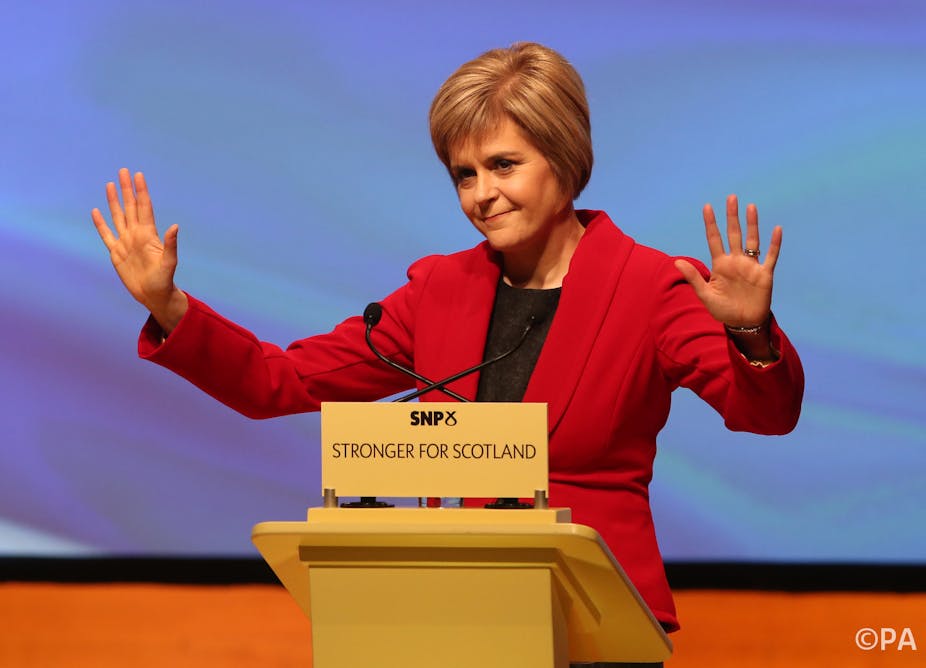Prime Minister David Cameron has insisted on the inclusion of the Green party if televised leaders debates are to go ahead as part of the general election. While Cameron’s motives could lie anywhere between the principle of fairness to political self interest, he may in fact have a point.
Research shows that the public has a clear appreciation of the role and input of a diverse range of leaders in televised political debates. It suggests that the inclusion of the Greens and possibly other parties into the debates for the general election may well be beneficial for broadcasters, parties, and viewers alike.
A collaborative team from Robert Gordon University’s IMaGeS and IDEAS Research Institutes mapped out in real time the Twitter response to three televised debates before the Scottish referendum. Our research offers a unique insight into how television audiences reacted to a multi-party panel, and the inclusion of the Green party, in a nationally televised political debate only a few months ago.
Referendum lessons
In the lead up to the Scottish independence referendum, there were two debates between Alex Salmond and Alistair Darling, and one “town hall” style debate on September 2, with a panel of six debaters. As well as Patrick Harvie from the Scottish Greens and Douglas Alexander from Labour, the panel included four women – the Scottish National Party’s Nicola Sturgeon; Scottish Labour’s Kezia Dugdale; the Scottish Conservatives’ Ruth Davidson, and actor Elaine C Smith.
In our Twitter sampling, 79% of the comments made about Patrick Harvie were positive, in contrast to, for example, 58% of comments about Nicola Sturgeon, 21% about Douglas Alexander or 12% about Ruth Davidson. The only other person to come close to Harvie was Elaine C Smith, with 68% of the comments about her being positive.
Comments about Harvie focused on his ability as a debater, describing him as “eloquent”, “unflappable” and “a fresh breath of air”. Tweeters also praised his contribution to the campaign as a whole. Indeed, even before he spoke, his contribution was being anticipated by some tweeters: “Yay, it’s Patrick next!”
One of the reasons must be that – unlike the other politicians on the panel – the Greens were not burdened with the realities of having been in power in either Scotland or the UK, as the other parties involved were. In effect, Harvie benefited in a similar way to that of Nick Clegg in the general election political debates of 2010.
The Twitter sample was also extremely positive about the diversity of viewpoints on display in this debate, commenting favourably on the range of opinions and argument featured and the civilised style of discussion. It was held up in contrast to the combative style of the two earlier head-to-head debates featuring Alex Salmond and Alistair Darling.
“Pleasingly more temperate than the Salmond Darling clashes,” one user said. “#ScotDecides one of best political TV debates for many a year. Informed, diverse, courteous and genuinely participatory,” said another. Within our Twitter sample, the Salmond-Darling debates were criticised for being too “shouty” and full of childish point-scoring.
More women
Several tweeters suggested that one of the reasons for the more pleasant experience was the inclusion of women in the debate. “Finding this easier to listen to. Maybe coz more women involved,” one Tweeter said. Of course, the inclusion of Natalie Bennett of the Green Party (and possibly also Nicola Sturgeon of the SNP and Plaid Cymru’s Leanne Wood) in the general election debates would ensure the inclusion of both sexes this time around. There were also many positive comments about the fact that Harvie and Davidson are bisexual/gay.
As well as ensuring a good viewing experience for audiences, the minor parties have much to gain from appearing in the upcoming debates. Both Kezia Dugdale and Nicola Sturgeon were placed firmly in the limelight, and subsequently rose to become leader and stand-in leader for their respective parties. One discussion between them during the first debate was referred to as “a preview of First Minister’s Questions 2016”.
Overall, our sample of tweets showed that the diversity of the panel for this last referendum debate produced the most informative and enjoyable debate on the topic. Our research shows that including minor parties with a more diverse range of leaders in the televised debates will make for a better experience for viewers, and perhaps even for the debaters themselves.

